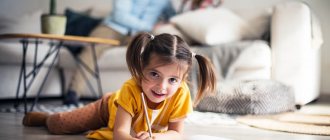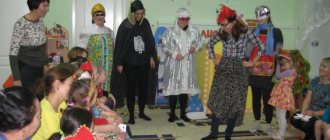Self-analysis of an open integrated lesson in the junior group “Kids visiting animals”
Self-analysis of an open integrated lesson in the junior group “Kids visiting animals.”
This open lesson on the topic “Kids visiting animals” was conducted with 4 children of primary preschool age 3–4 years old.
This activity is complex, it combines educational areas: cognition, socialization, communication, fiction, physical education, artistic creativity and music. All elements of the open lesson are united by a common theme about forest animals. The lesson was carried out in accordance with the notes. The summary was compiled independently. When developing this lesson summary, I first of all took into account the age, mental, and individual characteristics of children in the younger group. Taking all this into account, I outlined the goal, objectives, content of the lesson, determined the form of delivery, methods, techniques and means necessary for positive results.
Purpose of the lesson: Improve and systematize children’s knowledge about wild animals
I was assigned the following tasks:
Correctional and educational:
- Activate the speech and intellectual activity of children through the use of presentation slides and play activities;
- Expand knowledge about the world around you;
- Learn to distinguish between wild and domestic animals, the characteristic features of the appearance of animals, clarify the names of dwellings, habits;
- Activate the subject dictionary (den, hollow, hole, lair), the dictionary of signs (long - short, large - small, prickly, cunning, cowardly);
- Practice counting within 5, knowing and distinguishing numbers;
- Strengthen ideas about geometric shapes.
Correctional and developmental:
- Develop children's cognitive activity;
- Develop interest in living nature, emotional responsiveness;
- Develop gross and fine motor skills, coordination of speech with movement;
- Develop thinking, memory, visual and auditory attention.
Correctional and educational:
- Foster a caring attitude towards living nature;
- Develop skills of kindness and cooperation in the game;
- Develop the ability to listen carefully to the teacher and the answers of other children;
- Cultivate neatness.
I introduced gaming motivation into the lesson: A trip to the spring forest, to visit forest animals.
During the lesson, learning was structured as an exciting problem-based game activity. Traveling on a train, children performed various tasks. This activity created a positive, emotional background for the learning process, increased children’s speech activity and maintained interest throughout the lesson.
During the lesson, I used visual, verbal and practical techniques aimed at using speech, cognitive, motor, practical skills and abilities and improving them. The proposed tasks were given in order of increasing complexity, which contributed to the solution of the assigned tasks for the development of attention, imagination, memory, speech and artistic and aesthetic perception. Throughout the entire lesson, the children were friendly, responsive, and helped each other.
The type of lesson is complex. Which contributes to solving the assigned tasks in a comprehensive manner.
All stages of the lesson were interconnected and interdependent, subordinated to the given topic and goals of the lesson. Changing the type of activity at each stage of the lesson helped prevent fatigue. Children dynamically switched from word games to playing with objects and drawing.
The structure of the lesson corresponded to the assigned tasks. To implement each task, techniques were selected in an interesting and entertaining form. The lesson is structured in a logical sequence and interconnection of its parts. The pace of the lesson is optimal. Speech rate is moderate. The material was presented emotionally.
The material is selected at a level accessible to children. Taking into account age characteristics, the children answered the teacher’s questions, maintained a conversation, observed with interest, examined, guessed (writing) and made an applique with sand. The children were quite active, felt comfortable, and willingly took part in the games.
During the open lesson, the following work methods were used: playful (use of surprise moments; such as a box, finger gymnastics), visual (use of illustrations, Game “Guess by Silhouette”, “Who eats what?”, “Find a card with a word”, Scribing). , animal imitation game “Family” game), verbal (reminders, instructions, questions, children’s individual answers), lesson analysis, encouragement.
Demonstration material was prepared for each moment of the lesson. As well as handouts: blanks of geometric shapes and ready-made pictures, cards on which animals were written, colored sand, sheets of A4 paper according to the number of children, plates for applique details, glue, brushes, oilcloths, napkins by the number of children.
Analyzing the activities of children in class, I would like to note that they showed cognitive activity, reacted emotionally to methods of activating activities, and used existing knowledge and skills. They were interested, attentive, organized. Children were offered tasks that encouraged them to solve assigned problems. Encouraged indecisive and shy children to speak out. Music was used during the lesson to enhance emotional perception.
The duration of the lesson is 20 minutes, which corresponds to the standards of San PIN. At all stages of the lesson, the speech, cognitive, and motor activity of children intensified
A method of control and stimulation in the form of approval and praise.
Analyzing the lesson, we can say that the assigned tasks were successfully completed. I believe that the lesson is structured logically, and the stages of the lesson are interconnected.
The logical structure of the lesson made it possible to conduct it without going beyond the time allotted for completing the task.
I think that the game motivation aroused the interest of the children and the activity was quite high. However, the children worked at their own pace and completed the creative task a little later, not because of slowness, but because of their individual capabilities. Although this does not indicate that they have less skills and knowledge.
The children pleased me that the kindness of the child’s soul, their curiosity was felt throughout the entire lesson and in the practical part of the lesson. According to a survey of children, it was revealed that everyone liked the trip, and they would like to visit the spring forest again and meet the forest inhabitants.. I believe that all the program tasks I set during the lesson were solved.
Thank you for your attention!
Self-analysis of educational activity on socialization “Our friendly family” in the younger group
Self-analysis of educational activity on socialization “Our friendly family” in the younger group
We were brought to your attention directly
educational activity for
socialization “
Our friendly family ”
in the younger group
.
Dominant educational field " Socialization"
"
integrates with the following educational areas: "Cognition"
,
"Communication"
,
"Artistic Creativity"
.
Goal: Formation of an idea of the family and its members
was achieved by solving the assigned tasks:
— Expand children’s ideas about family
, as about people who live together, clarify the concepts of
“
family ”
, “relatives”
.
— Form ideas about the friendly relations of relatives and the emotional state of family
, the dependence of this state on the current situation.
— To consolidate quantitative and ordinal counting within 5, to develop orientation in space.
— Develop dialogical speech; Encourage children to be active when answering questions.
— To attract children to the fine arts, using non-traditional imaging techniques; consolidate drawing techniques with felt-tip pens.
— Cultivate love and respect for your family and friends.
Socialization process
A preschool child includes a wide range of tasks, and to successfully solve them, I used a number of pedagogical methods and techniques, taking into account the age characteristics of children:
Verbal: conversation, game “Basket of Good Deeds”
.
Visual: showing story pictures, game exercise “Make a family”
»
Practical: finger gymnastics « Family
"
, valeological pause, creative task "Draw
a family "
.
Organizational technique (low mobility game “How do you live?”
) was aimed at developing communicative skills, establishing
friendly
relationships both within the children's team and between the teacher and children.
All aspects of GCD are logical and consistent, subordinated to one theme.
I built the structure of the GCD in such a way that the knowledge children acquired early is the basis for assimilation of new information, and it, in turn, will work on subsequent topics. I used questions of a search nature, tested intelligence and logical thinking, created problematic situations - all this contributed to the effectiveness of our game, increasing cognitive and mental activity.
I "expanded"
children's ideas about
family
, through new concepts
of “clan”
,
“relatives”
and taught kids to draw
family
using unconventional depiction techniques.
The outcome of the activity was organized in the form of a didactic game “Magic Daisy”
so as to check the quality of learning the material and the implementation of the educational task.
The following types of children's activities were intensified: play, motor, communicative, productive.
She encouraged and praised the children not only in terms of solving cognitive and communication problems, but also in order to consolidate their situation of success.
The relationship between me and the children was built on the subject-subject principle. I tried to be in the “nearby”
.
The children showed their knowledge not only theoretically, but also practically. The necessary skills are best learned in games with specially targeted content, so I tried to make it interesting and educational for the children. I was able to activate their initiative, logic and creativity.
I believe that the program objectives set during the NOD were resolved.
Thank you for your attention, I am ready to answer your questions.
Photo. Application
Self-analysis of an open lesson in the second junior group “Bear in a den”
Tatyana Sizova
Self-analysis of an open lesson in the second junior group “Bear in a den”
This open lesson was conducted with 12 primary
When planning an open lesson, the age characteristics of the children were taken into account. All elements of the open lesson are united by a common theme about forest animals. The lesson was carried out in accordance with the notes. The abstract was compiled independently . The following tasks were set:
- Learn to notice the beauty of winter nature,
— Expand knowledge about forest animals,
- Learn to navigate the location of parts of your body and on a piece of paper, in accordance with them, distinguish spatial directions: top - bottom, right - left, middle,
- Learn to compare objects by height, overall size,
— Learn independently glue finished parts onto a piece of paper,
- Develop accurate work skills
- Induce joy in children from the resulting image,
— To cultivate responsiveness to music and singing, literary works that children can understand.
The structure of the lesson corresponded to the assigned tasks. To implement each task, techniques were selected in an interesting and entertaining way. The lesson is structured in a logical sequence and interconnection of its parts. The pace of the lesson is optimal . Speech rate is moderate. The material was presented emotionally.
The material is selected at a level accessible to children. Taking into account age characteristics, the children answered the teacher’s questions, maintained a conversation, watched with interest, examined them, willingly answered questions, independently finished a line of a poem, and made an appliqué. The children were quite active, felt comfortable, and willingly took part in the games.
During the open lesson, the following working methods were used:
1. Gaming (use of surprise moments,
2. Visual (use of illustrations, ICT)
3. Verbal (reminders, instructions, questions, individual answers from children)
4. Analysis of the lesson , encouragement.
Demonstration material was prepared for each moment of the lesson
— Sleigh (theater screen)
— ICT D/I “Who hid?”
— Videos: “The Joy of the Winter Forest”
, educational video
“Why
does a bear sleep in winter ?” — Audio recordings: Music by A. Alexandrov, words by M. Evensen “Guests have come to us”
(minus, P.I. Tchaikovsky
“Seasons - Winter”
)
Handout:
— Blanks of geometric shapes and ready-made pictures, cotton wool, sheets of A4 paper according to the number of children,
— Plates for applique details,
- Glue, brushes, oilcloths, napkins according to the number of children.
during the lesson to enhance emotional perception.
I believe that the form of organizing the lesson for children that I chose was quite effective.
Flaws:
1. Regarding the organization of the workplace, there were not enough oilcloths to place parts for spreading with glue.
2. Due to the fact that the children are small, there were many choral responses, I plan to pay special attention to individual responses. It is also necessary to achieve clear pronunciation of words. Work on sound pronunciation, expand active and passive vocabulary.
Despite this, I believe that all the program tasks I set during the lesson were solved .
The children pleased me that their curiosity and activity was felt throughout the entire lesson . A survey of children revealed that everyone enjoyed the trip and would like to visit the winter forest again.
Self-analysis of OOD in the first junior group (in the context of the Federal State Educational Standard). article (junior group) on the topic
Self-analysis of OOD in the first junior group
(in the context of the Federal State Educational Standard).
Topic: “Tea party with the doll Katya.”
Integration of areas of development of preschool children: “Social and communicative development”, “Speech development”, “Artistic and aesthetic development”.
Software tasks:
* Educational: introduce children to the names of tea utensils and their purposes.
* Developmental: develop speech, memory, attention, thinking, general motor skills, aesthetic perception.
* Speech: promote the development of interactive speech, enrich children's vocabulary with words: cup, saucer, sugar bowl, teaspoon.
* Educational: to cultivate compliance with basic rules of behavior at the table during tea drinking.
Preliminary work:
* reminding children of table manners while eating;
* examining illustrations depicting tea utensils;
* examining doll dishes and playing with them;
Enrich children's vocabulary: cup, saucer, teaspoon, teapot.
Individual work:
1. Continue teaching how to answer questions (repeat after the teacher), Kirill B, Kostya K.
2. Help the inactive, shy Ksyusha B. gain confidence in her abilities, encouraging her to answer the questions asked.
3. Develop self-control in Karina Sh. by instructing her to lay out napkins.
Methods and techniques:
* Practical.
* Visual (tea utensils)
* Verbal (questions for children)
* Gaming (surprise moment).
Analysis of goals and objectives.
The children were told the topic of the lesson. The structure of the lesson corresponded to the assigned tasks. It is built in a logical sequence and interconnection of the parts of the lesson. It was reasonable to divide the time between all parts of the lesson. The pace of the lesson is optimal. Speech rate is moderate. The material was presented emotionally.
When planning an open lesson, the age characteristics of the children were taken into account. The material is selected at a level accessible to children. The children answered the teacher’s questions correctly, maintained a conversation, watched with interest, examined them, willingly manipulated the tea utensils, and examined them. The children were quite active, felt comfortable, willingly took part in the game, and moved to the music.
All elements of the lesson are united by a common theme. The content of the lesson corresponded to the set goals: to develop children’s speech, communication skills, and to enrich their vocabulary; introduce children to the names of tea utensils and their purposes; develop vocabulary, auditory attention, horizons, thinking, memory; instill observance of basic rules of behavior at the table.
During the lesson, the following working methods were used: verbal (questions, clarification, reminder, encouragement); visual demonstration material (items of teaware); game material.
In the water part: organizing children, switching attention to activity, stimulating motivation for it. This was facilitated by examining tea utensils together with the teacher and manipulating them
The main part: the mental and practical activity of children, tasks were included on mental, speech development and perception of the world around us, systematization of existing knowledge, and consolidation of speech skills. To relieve general fatigue, playful activities and musically rhythmic movements were carried out.
Individual work was manifested in carrying out vocabulary work, in providing assistance to those who have difficulty, taking into account the peculiarities of thinking and the pace of perception of children.
I believe that the form of organizing the lesson for children that I chose was quite effective. I complied with the norms of pedagogical ethics and tactics. I believe that the tasks set during the lesson were completed by the younger preschoolers in my group.



